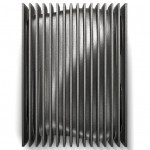High Speed External Storage Devices
External storage devices are a quick and cheap way to increase storage space on your desktop or laptop. These are available in portable format using Solid State Drives (SSD) or 2.5″ Hard Disk Drive (HDD) and in desktop format using 3.5″ HDD(s). While disk drives are given bandwidth throughput of up to 300MB/s using the second generation SATA II interface and 600MB/s using the third generation SATA III interface, most drives rarely take full advantage of the bandwidth due to mechanical or technological limitations.
The High Performance Hard Disk Factors
When looking for performance in an external storage device one has to consider not only the interface (SATA II or SATA III) but the type of drive (Solid State or Hard Disk Drive) and the type of connection. High performance SSD drive with SATA III interface can achieve up to 550/520 MB/s sequential read and sequential write respectively. The same SATA III drive connected to a SATA II port limits its performance up to only 285/275 MB/s. While a high performance HDD with SATA III interface can achieve around 203.9/208.8 MB/s sequential read and sequential write.
As for the type of connections or I/O, the USB 2.0 supports a transfer rate of up to 480Mbps, FireWire 800 up to 800Mbps, Express Card up to 2.5Gbps and USB 3.0 up to 5Gbps. A new kind of high speed connection, developed by Intel, called the Thunderbolt is capable of up to 10Gps data transfer rate, doubles that of USB 3.0. Thunderbolt was first featured on Apple’s range of MacBook Pro laptops and is now available on peripheral and external data storage devices.
The third factor to consider is the presence of RAID or Redundant Array of Independent Disks. RAID is a system that allows two or more drives to be connected and configured as one large volume. The system allows for data to be split and written or read simultaneously across two or more disks for increased performance or the same data is duplicated automatically, with simultaneous write to create a mirrored disks as a sort of real-time back up.
Top 5 Best External Hard Drives
We start by looking at two external storage based on SSD drives, one with USB3.0 connection from Lacie and the other, Thunderbolt from Elgato.
We then look at a dual drive RAID device with Thunderbolt port from G-Technology and a buy your own hard drive solution that provides both USB3.0 and Thunderbolt or Gigabit Ethernet connectivity from Drobo.
Lastly, we look at an offering from Western Digital that uses high spinning hard drives coupled with two Thunderbolt ports.
The LaCie S+ark Blade Runner
For those wanting to make a fashion statement, Lacie Blade Running designed by Philppe Starck does it better than anything else in the market at the moment. The limited edition Blade Runner has aluminium fins around its body easily making it the coolest running 4TB USB 3.0 hard drive in the world.
The fins surrounds the actual housing of the hard disk, and this is not your typical rectangular box. The housing is anthropomorphic shape, think of it as a clump of liquid metal that has solidified.
The power button is in a shape of a cross, a Philippe Stark signature and doubles up as a status LED, orange when running and green when in Eco Mode. It doesn’t stop with its looks.
There is more to the Blade Runner than its good looks, the USB 3.0 interface (also backward compatible with USB 2.0) provides an amazing data throughput of up to 5 GBbps. Compare this to USB 2.0 with it’s maximum transfer rate of 480 Mbps. However, the USB 3.0 connection and the 7200rpm SATA III drive yields a data transfer throughput of up to 177MB/s and 176MB/s on sequential read and write respectively.
Specifications
- Capacity: 4TB
- Hard Disk Type: 3.5-inch HDD (Hard Disk Drive)
- Interface: 1 x USB 3.0 (up to 5Gbps) backward compatible with USB 2.0 (up to 480Mbps)
- Dimensions: 141mm (W) x 193mm (D) x 74mm (H)
- Weight: 2 kg
Elgato Thunderbolt™ SSD
The Thunderbolt interface is twice as fast as the USB 3.0 at 10Gbps. Although Apple’s MAC was first to adopt the interface licensing this from Intel, we are beginning to see more PC makers (Acer, Asus and Lenovo) doing the same for their devices which can only be good news for everyone.
The bus powered portable drive achieve a transfer rate of 1GB of data in 10 seconds thanks to the Thunderbolt technology. The reported throughput is 270 MB/s, compare this to USB 3.0 at 110 MB/s, Firewire at 80 MB/s and USB2 at 35MB/s. Solid state driver are less prone to accidental damage as it has no moving parts, which also means complete silent operation.
In the looks department, there is really nothing to shout about. The Elgato Thunderbolt drive is your typical rectangular drive albeit with rounded corners. If anything the solid built redeems the device. The enclosure is made from solid metal with a brushed finish in dark gray. Here is what others have to say:
“If you need quick and portable fast storage today, the Elgato Thunderbolt SSD is a solidly constructed external SSD that works well with Thunderbolt-equipped PCs.”
-Andrew Harrison, PC Advisor
“it took less than 20 seconds to transfer 2GB of video from the Mac to the drive. These numbers are a godsend to video producers, graphic designers, and photographers who need external storage that won’t lag behind. This is, quite literally, the fastest portable drive we’ve ever seen”
– Florence Ion, MacLife.com
Available in 120GB and 240GB capacity and comes complete with 3 years warranty, the Elgato Thunderbolt ™ SSD is recommended for those looking for portable storage without compromising on performance.
Specifications
- Capacity: 120 GB, 240 GB
- Hard Disk Type: SSD (Solid State Drive)
- Interface: 1 x Thunderbolt for MAC only
- Dimensions: 83mm (W) x 131mm (D) x 21mm (H)
- Weight: 270 g
G-Technology G-RAID with Thunderbolt™
This is a graphic designer or video editors dream come through, not only is the G-RAID super fast internally, it also employs the fast Thunderbolt port that transfers files up to three times faster than USB2. and twice faster than USB3.0.
Given that it is based on a RAID configuration, an array of drives plugged together to give you a mega size storage at 8TB, the G-RAID is not only fast but has an enormous appetite and will swallow all your digital data. Inside the box there are 2 x 4TB 7200 RPM SATA III hard drive with 32MB cache memory per drive ( up to 64MB Cache in total) in a RAID 0 (stripped) configuration for maximum performance providing a data transfer rate of up to 250MB/s.
The design is also akin to the iconic Power Mac and the Mac Pro with brushed aluminium finish and stamped metal grill on the front for ventilation. The G-RAID is Time Machine ready and supports plug and play on Mac OS and come with 3 years warranty. We found the 8TB G-RAID on Amazon and the 4TB G-RAID .A baby brother without RAID configuration at 4TB capacity called the G-DRIVE is also available.
Specifications
- Capacity: 4TB, 8TB
- Hard Disk Type: HDD drive(s)
- Interface: 1 x Thunderbolt for MAC only
- Dimensions: 130mm (W) x 235mm (D) x 87mm (H)
- Weight: 2.43 kg
DROBO Mini and Drobo 5(D/N) Series
Drobo Mini Portable 4-bay Storage Array takes up to 4 x 2.5″ hard drives. Taking it’s cues from rack mounted servers, with front loading drives arranged horizontal over two layers, the 2 by 2 configuration gives the Drobo mini a low profile. The 4 hot swappable bays does not require carriages or screws and is designed in a way that inserting or removing drives is as easy as clicking in and out the hard drive.
Drobo 5D and Drobo 5N on the other hand is the bigger brother of the Drobo mini. Both based on the same chasis, is a desktop cousin of Drobo mini and uses 3.5″ hard drives instead of 2.5″. While the Drobo 5D comes with Thunderbolt and USB 3.0 interface, the Drobo 5N comes with a single Gigabit Ethernet connection. It would be nice if the Drobo 5N comes with the option of using a direction connection as well as the Gigabit Ethernet network connection. Both 5D and 5N as the number suggests, supports up to 5 x 3.5″ drives.
All Drobo desktops and mini supports BeyondRAID. Unlike RAID, it allows for single-drive redundancy. Conventional RAID (Redundant Array of Inexpensive Disks) requires at least 2 drives for redundancy. Adding additional storage of drive is also as easy as plugging in the hard drive, or hot swapping the small drive with a big one, without having to reconfigure the RAID, providing users zero downtime.
An there is more, both Drobo Mini and the desktop (5D/5N) variant comes with a single mSATA Solid State Drive slot. This allows high performance Solid State Drives, which are sold separately to work with existing hard drive(s) in the normal bay to create what is called Data-Aware Tiering. The technology intelligently uses the SSD to accelerate the performance of the storage array. The result, an SSD accelerated storage and allows applications to run faster. We have seen the same technology in Hybrid hard disks where solid state memory is combined with conventional spinning discs to provide faster system boot-up and faster access to frequently used data and applications.
As with the size of storage, users are free to choose from the type of drives to use, or find from a list of recommended drives here. For best performance we recommend Solid State Drives or Solid State Hybrid Drives in the hot swap bays and get the optional mSATA solid state drive. Currently, the biggest capacity on an SSD is 600GB, a 2.5″HDD is 2TB and a 3.5″ HDD is 4TB. This means a fully loaded Drobo Mini is 2.4TB with 4 x 600GB SSD. A fully loaded Drobo 5D/5N is 20TB with 5 x 4TB HDD. Typical mSATA add-on card capacity starts from 32MB to 256MB.
Specification
- Capacity: Depends on chosen hard drive(s) up to 2.4TB (Drobo Mini), 20TB (Drobo 5 series), see compatibility table
- Hard Disk Type: SSD (Solid State Drive), HDD (Hard Disk Drive), mSATA card
- Interface: 2 x Thunderbolt (second Thunderbolt port for daisy changing Thunderbolt devices,MAC only) and 1 x USB 3.0 on Drobo Mini and Drobo 5D, 1 x Gigabit Ethernet port on Drobo 5N
- Dimensions: 187.2mm (W) x 180mm (D) x 44.6mm (H) for Drobo Mini, 150.3mm (W) x 262.3mm (D) x 185.4mm (H) for Drobo 5 Series
- Weight: 2.2lb for Drobo Mini without hard drive(s), 8.5lb for Drobo 5 Series without hard drive(s)
Western Digital My Book VelociRaptor Duo
Here is another high performance storage with RAID that can be configured for data protection (RAID 1 with Redundancy) or performance (RAID 0 with Striping). My Book VelociRaptor Duo is a dual drive system, limiting the RAID configuration options to RAID-0 and RAID-1. The RAID’s performance and reliability is derived from two 10,000 RPM WD VelociRaptor drives and the speedy Thunderbolt interfaces. There is also no short of cache as each of these drives comes with 64MB of cache memory, giving the device a total of 128MB cache.
There are two Thunderbolt ports on the unit allow users to easily daisy chain more drives to increase storage capacity. The second port can also be used to connect Thunderbolt enable peripherals.
The RAID option is user configurable in order to customise the system to their needs. Obviously, choosing RAID 1 means losing half the storage capacity but gives you peace of mind as each copy of the data is duplicated across both drives. RAID 0 or stripping on the other hand allows simultaneous read or write to the drives effectively saving up to half the time, providing the performance and storage you need. If RAID is not your thing, you can choose to use each of the drives individually in JBOD (Just a Bunch of Drives) mode. The third option offers no real performance or data protection benefits.
In terms of performance, WD claims that the VelociRaptor Duo can achieve more than 400MB/s when the device is configured in RAID 0. The Thunderbolt connector provides dual channels throughput of up to 10Gbps transferring in both directions. Moving a 5GB movie file takes 15 seconds, while a 22GB HD movie takes 65 seconds. Moving multiple image files 2000 images at 5MB each takes 33 seconds, while 500 songs at 5MB each takes a mere 8 seconds.
Another useful and notable feature for MAC users its ability to act as an externally bootable device. Mac OS X Lion or Mountain Lion supports recovery from bootable device. Apple’s OS X Recovery provides all the tools you need to reinstall OS X, repair your disk and even restore from a Tim Machine backup without using optical discs.
The only disadvantage of this product is that it is only available in 2TB. This is because at the time of writing, the maximum capacity on a drive capable of 10,000 rpm is 1 TB. A small price to pay if you are looking to open and render that 3D image or touch up your mega pixel image in record time. WD VelociRaptor Duo.
Specifications
- Capacity: 2TB
- Hard Disk Type: 2x 1TB HDD (10,000 rpm) with 64MB cache each, preconfigured as RAID-0 for speed, configurable to RAID-1 or JBOD
- Interface: 2 x Thunderbolt for MAC only
- Dimensions: 99mm (W) x 157mm (D) x 165mm (H)
- Weight: 1.9 kg
Final Thoughts
The 5 external storage devices reviewed here provides a look at the different configurations possible for performance.
Ultimately, the type of drive, the connector(s) and RAID are factors that determines the performance of these devices.
The question here is which of these drives is a right fit for you. If you are looking for portability, go with the Elgato SSD drive with Thunderbolt.
If you are look for ease of use and you don’t need a Thunderbolt connection, go with Lacie’s Blade Runner but if you do need the Thunderbolt connection and still prefers an easy to use out of the box experience then pick the WD VelociRaptor Duo or G-RAID with Thunderbolt .
The only difference between VelociRator Duo and G-RAID is that the former uses 10,000 rpm drives while the later uses 7200 rpm drives.
However, if you are a power user and don’t mind installing hard disks yourself, choose the Drobo solution.
Drobo is not only a high performing storage option but gives you the most flexibility in terms of size of drives to install and room for future upgrade.












































